University Management Report: L&D Practices, Trends, and Roles
VerifiedAdded on 2022/08/22
|17
|4542
|23
Report
AI Summary
This report provides an evaluative summary of current practices, trends, and emerging roles in Learning and Development (L&D). It discusses the impact of technology on L&D, contrasting approaches from 15 years ago with contemporary methods, and highlights the influence of baby boomers and millennials. The report examines the skills needed by L&D professionals, including adaptability, understanding client needs, and problem-solving. It references the CIPD professional map, focusing on key behaviors such as collaboration and decision-making. Furthermore, the report explores the importance of learning approaches, diversity, and ROI. It also addresses emerging roles like content developers and talent development managers, emphasizing the use of e-learning tools and the evolution of traditional trainer roles. The report includes a discussion on personal development plans, team dynamics, and negotiation strategies. The report provides a comprehensive overview of the key aspects of the L&D field, making it a valuable resource for students and professionals alike. The report also makes reference to the importance of team dynamics and negotiation skills and analyses the impact of these skills on the learning and development environment.
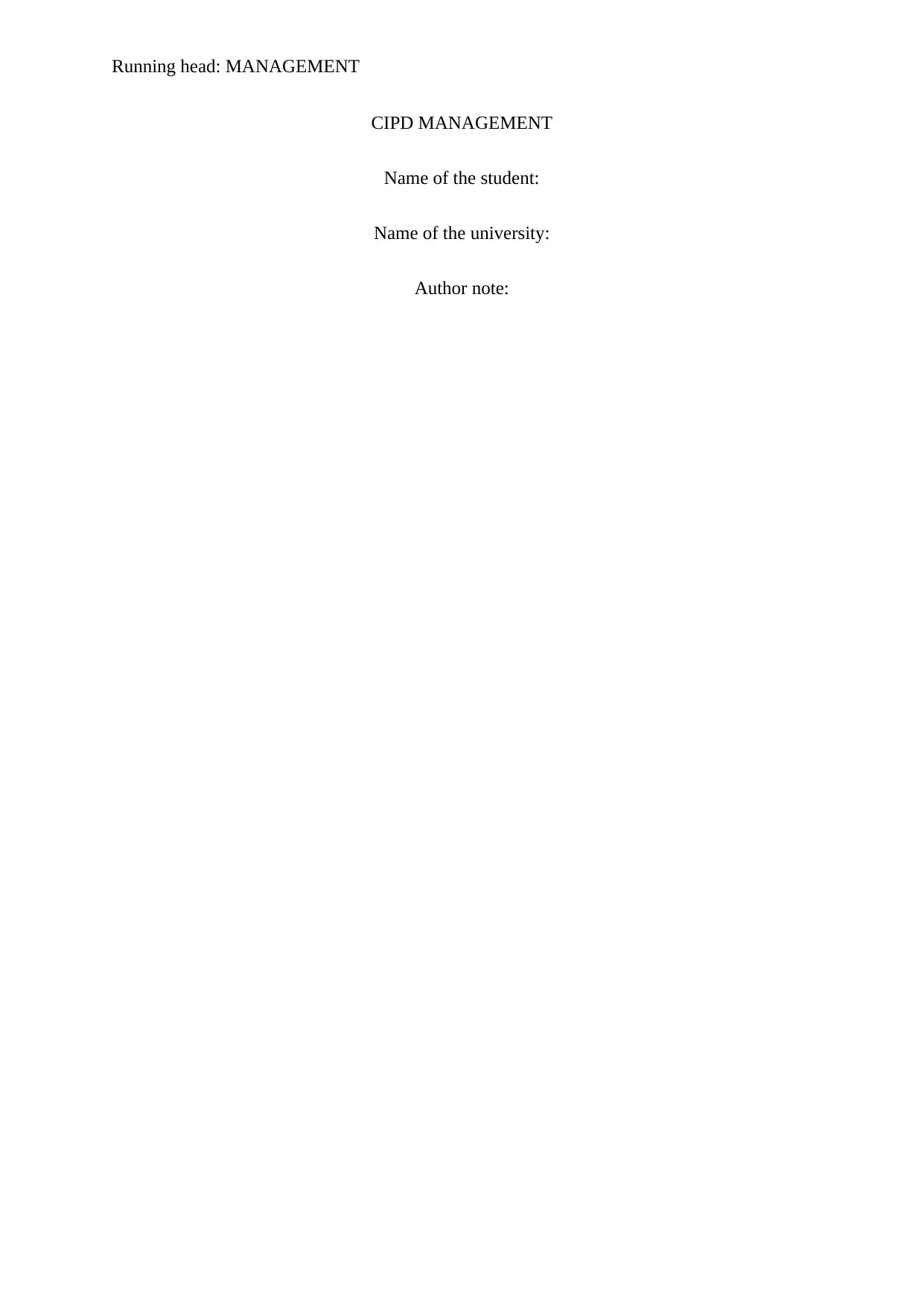
Running head: MANAGEMENT
CIPD MANAGEMENT
Name of the student:
Name of the university:
Author note:
CIPD MANAGEMENT
Name of the student:
Name of the university:
Author note:
Paraphrase This Document
Need a fresh take? Get an instant paraphrase of this document with our AI Paraphraser
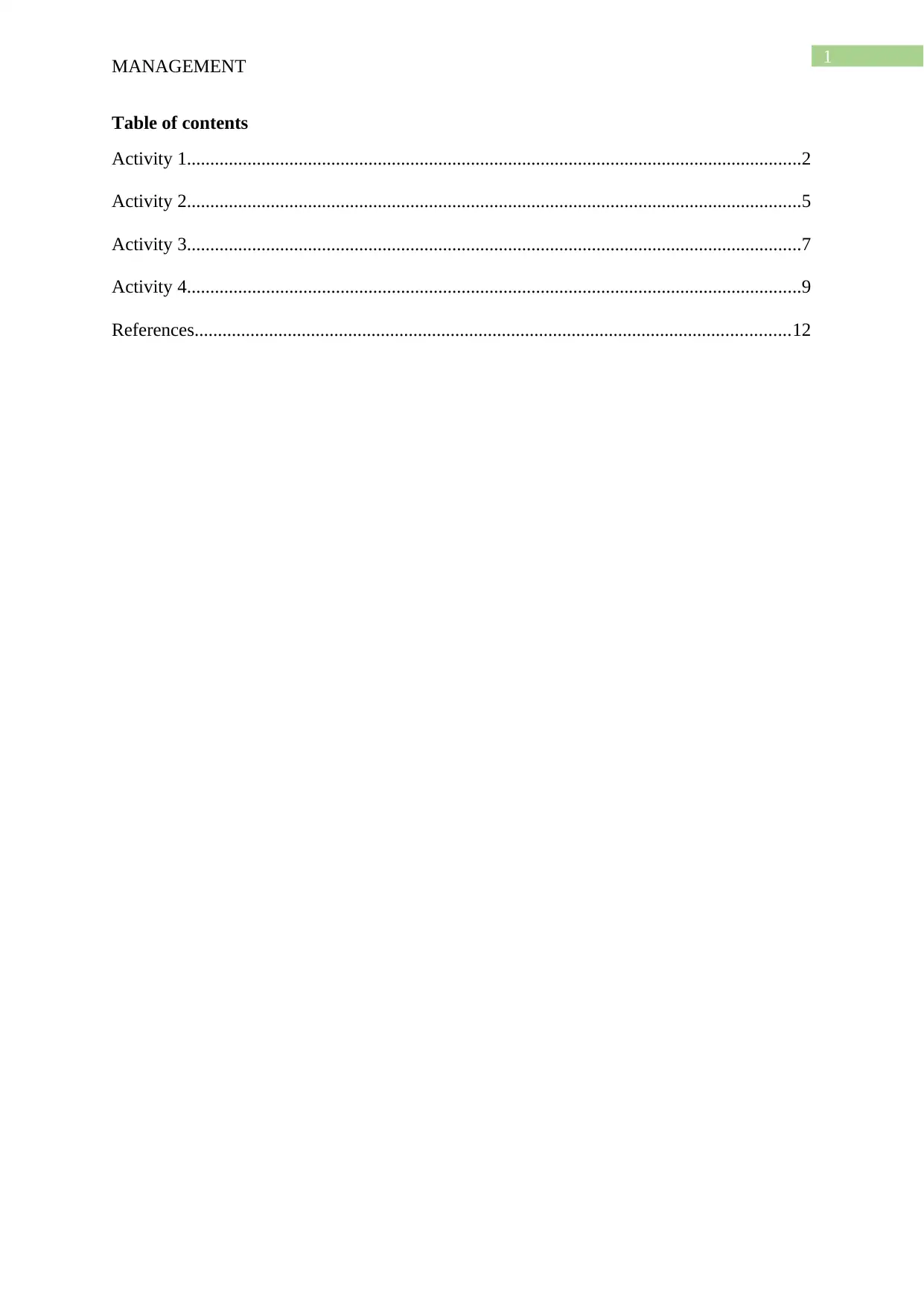
1
MANAGEMENT
Table of contents
Activity 1....................................................................................................................................2
Activity 2....................................................................................................................................5
Activity 3....................................................................................................................................7
Activity 4....................................................................................................................................9
References................................................................................................................................12
MANAGEMENT
Table of contents
Activity 1....................................................................................................................................2
Activity 2....................................................................................................................................5
Activity 3....................................................................................................................................7
Activity 4....................................................................................................................................9
References................................................................................................................................12
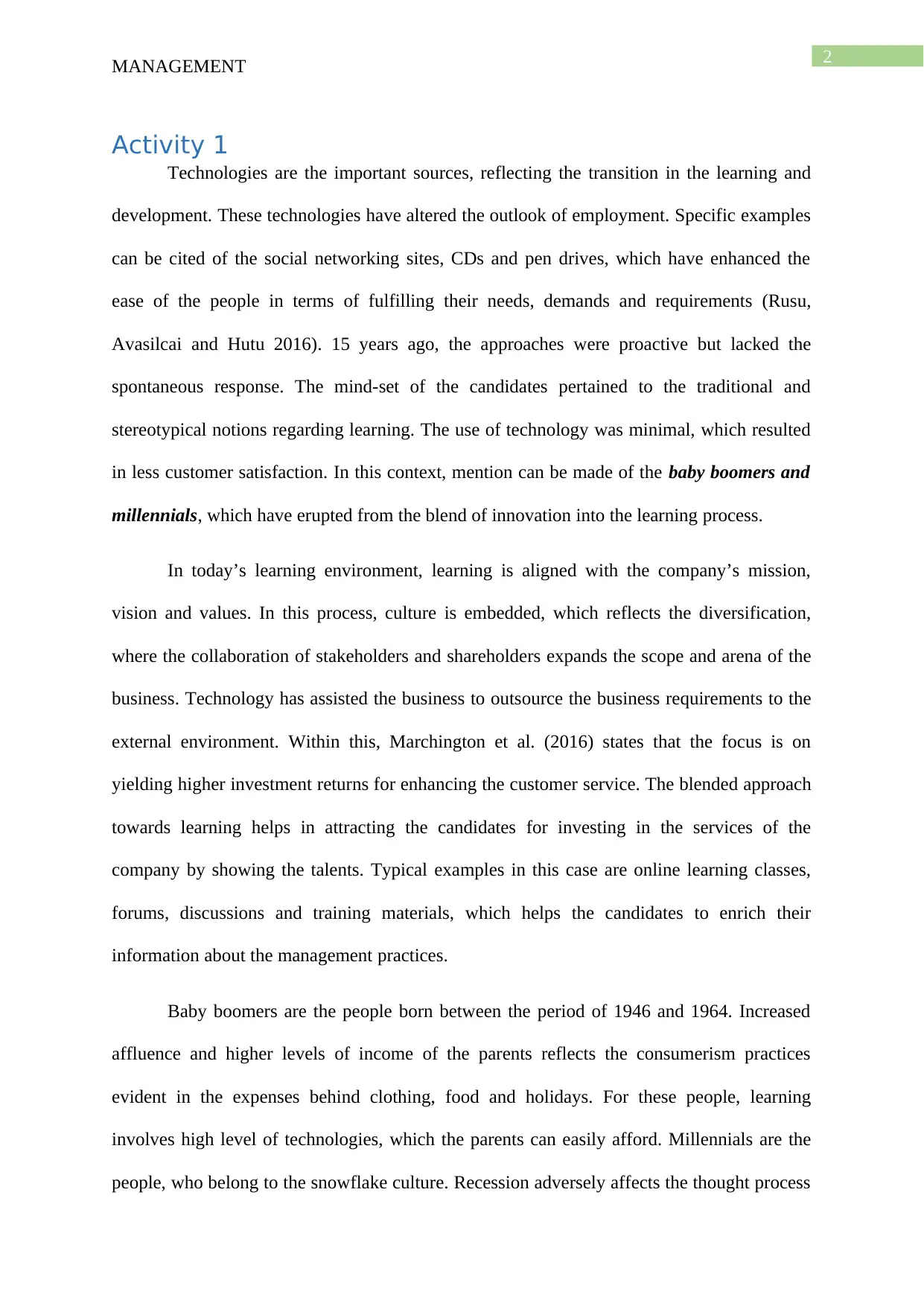
2
MANAGEMENT
Activity 1
Technologies are the important sources, reflecting the transition in the learning and
development. These technologies have altered the outlook of employment. Specific examples
can be cited of the social networking sites, CDs and pen drives, which have enhanced the
ease of the people in terms of fulfilling their needs, demands and requirements (Rusu,
Avasilcai and Hutu 2016). 15 years ago, the approaches were proactive but lacked the
spontaneous response. The mind-set of the candidates pertained to the traditional and
stereotypical notions regarding learning. The use of technology was minimal, which resulted
in less customer satisfaction. In this context, mention can be made of the baby boomers and
millennials, which have erupted from the blend of innovation into the learning process.
In today’s learning environment, learning is aligned with the company’s mission,
vision and values. In this process, culture is embedded, which reflects the diversification,
where the collaboration of stakeholders and shareholders expands the scope and arena of the
business. Technology has assisted the business to outsource the business requirements to the
external environment. Within this, Marchington et al. (2016) states that the focus is on
yielding higher investment returns for enhancing the customer service. The blended approach
towards learning helps in attracting the candidates for investing in the services of the
company by showing the talents. Typical examples in this case are online learning classes,
forums, discussions and training materials, which helps the candidates to enrich their
information about the management practices.
Baby boomers are the people born between the period of 1946 and 1964. Increased
affluence and higher levels of income of the parents reflects the consumerism practices
evident in the expenses behind clothing, food and holidays. For these people, learning
involves high level of technologies, which the parents can easily afford. Millennials are the
people, who belong to the snowflake culture. Recession adversely affects the thought process
MANAGEMENT
Activity 1
Technologies are the important sources, reflecting the transition in the learning and
development. These technologies have altered the outlook of employment. Specific examples
can be cited of the social networking sites, CDs and pen drives, which have enhanced the
ease of the people in terms of fulfilling their needs, demands and requirements (Rusu,
Avasilcai and Hutu 2016). 15 years ago, the approaches were proactive but lacked the
spontaneous response. The mind-set of the candidates pertained to the traditional and
stereotypical notions regarding learning. The use of technology was minimal, which resulted
in less customer satisfaction. In this context, mention can be made of the baby boomers and
millennials, which have erupted from the blend of innovation into the learning process.
In today’s learning environment, learning is aligned with the company’s mission,
vision and values. In this process, culture is embedded, which reflects the diversification,
where the collaboration of stakeholders and shareholders expands the scope and arena of the
business. Technology has assisted the business to outsource the business requirements to the
external environment. Within this, Marchington et al. (2016) states that the focus is on
yielding higher investment returns for enhancing the customer service. The blended approach
towards learning helps in attracting the candidates for investing in the services of the
company by showing the talents. Typical examples in this case are online learning classes,
forums, discussions and training materials, which helps the candidates to enrich their
information about the management practices.
Baby boomers are the people born between the period of 1946 and 1964. Increased
affluence and higher levels of income of the parents reflects the consumerism practices
evident in the expenses behind clothing, food and holidays. For these people, learning
involves high level of technologies, which the parents can easily afford. Millennials are the
people, who belong to the snowflake culture. Recession adversely affects the thought process
⊘ This is a preview!⊘
Do you want full access?
Subscribe today to unlock all pages.

Trusted by 1+ million students worldwide
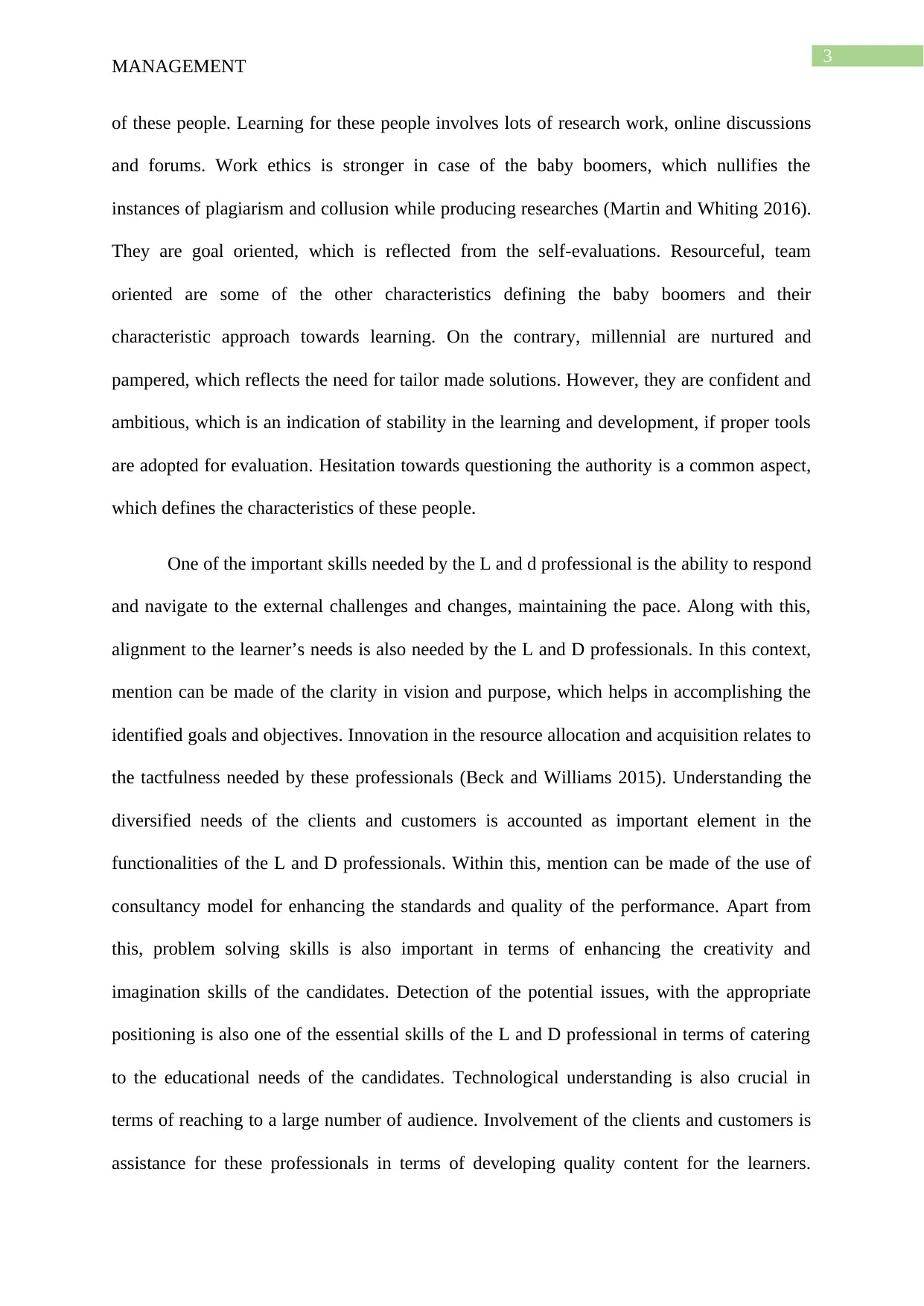
3
MANAGEMENT
of these people. Learning for these people involves lots of research work, online discussions
and forums. Work ethics is stronger in case of the baby boomers, which nullifies the
instances of plagiarism and collusion while producing researches (Martin and Whiting 2016).
They are goal oriented, which is reflected from the self-evaluations. Resourceful, team
oriented are some of the other characteristics defining the baby boomers and their
characteristic approach towards learning. On the contrary, millennial are nurtured and
pampered, which reflects the need for tailor made solutions. However, they are confident and
ambitious, which is an indication of stability in the learning and development, if proper tools
are adopted for evaluation. Hesitation towards questioning the authority is a common aspect,
which defines the characteristics of these people.
One of the important skills needed by the L and d professional is the ability to respond
and navigate to the external challenges and changes, maintaining the pace. Along with this,
alignment to the learner’s needs is also needed by the L and D professionals. In this context,
mention can be made of the clarity in vision and purpose, which helps in accomplishing the
identified goals and objectives. Innovation in the resource allocation and acquisition relates to
the tactfulness needed by these professionals (Beck and Williams 2015). Understanding the
diversified needs of the clients and customers is accounted as important element in the
functionalities of the L and D professionals. Within this, mention can be made of the use of
consultancy model for enhancing the standards and quality of the performance. Apart from
this, problem solving skills is also important in terms of enhancing the creativity and
imagination skills of the candidates. Detection of the potential issues, with the appropriate
positioning is also one of the essential skills of the L and D professional in terms of catering
to the educational needs of the candidates. Technological understanding is also crucial in
terms of reaching to a large number of audience. Involvement of the clients and customers is
assistance for these professionals in terms of developing quality content for the learners.
MANAGEMENT
of these people. Learning for these people involves lots of research work, online discussions
and forums. Work ethics is stronger in case of the baby boomers, which nullifies the
instances of plagiarism and collusion while producing researches (Martin and Whiting 2016).
They are goal oriented, which is reflected from the self-evaluations. Resourceful, team
oriented are some of the other characteristics defining the baby boomers and their
characteristic approach towards learning. On the contrary, millennial are nurtured and
pampered, which reflects the need for tailor made solutions. However, they are confident and
ambitious, which is an indication of stability in the learning and development, if proper tools
are adopted for evaluation. Hesitation towards questioning the authority is a common aspect,
which defines the characteristics of these people.
One of the important skills needed by the L and d professional is the ability to respond
and navigate to the external challenges and changes, maintaining the pace. Along with this,
alignment to the learner’s needs is also needed by the L and D professionals. In this context,
mention can be made of the clarity in vision and purpose, which helps in accomplishing the
identified goals and objectives. Innovation in the resource allocation and acquisition relates to
the tactfulness needed by these professionals (Beck and Williams 2015). Understanding the
diversified needs of the clients and customers is accounted as important element in the
functionalities of the L and D professionals. Within this, mention can be made of the use of
consultancy model for enhancing the standards and quality of the performance. Apart from
this, problem solving skills is also important in terms of enhancing the creativity and
imagination skills of the candidates. Detection of the potential issues, with the appropriate
positioning is also one of the essential skills of the L and D professional in terms of catering
to the educational needs of the candidates. Technological understanding is also crucial in
terms of reaching to a large number of audience. Involvement of the clients and customers is
assistance for these professionals in terms of developing quality content for the learners.
Paraphrase This Document
Need a fresh take? Get an instant paraphrase of this document with our AI Paraphraser
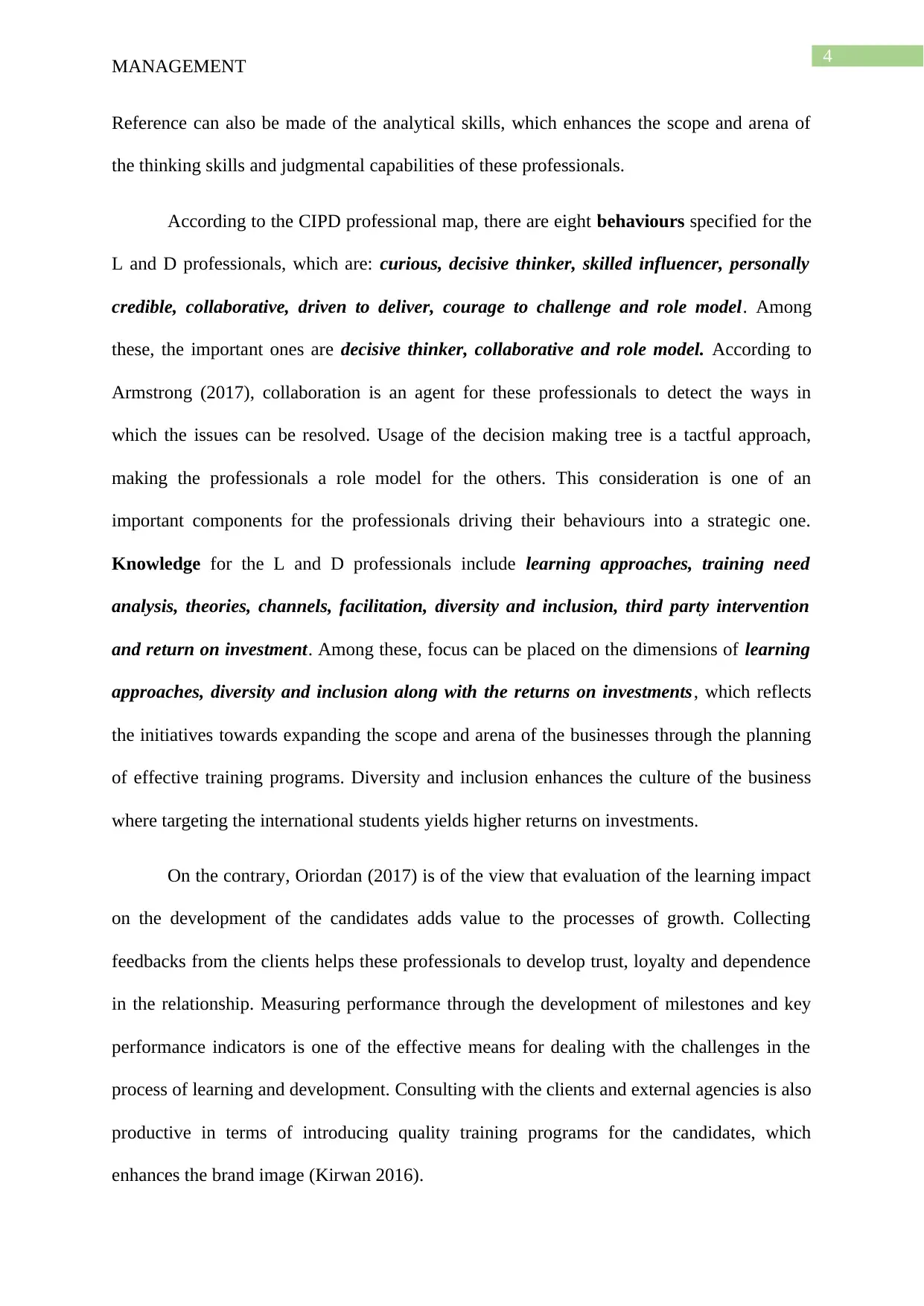
4
MANAGEMENT
Reference can also be made of the analytical skills, which enhances the scope and arena of
the thinking skills and judgmental capabilities of these professionals.
According to the CIPD professional map, there are eight behaviours specified for the
L and D professionals, which are: curious, decisive thinker, skilled influencer, personally
credible, collaborative, driven to deliver, courage to challenge and role model. Among
these, the important ones are decisive thinker, collaborative and role model. According to
Armstrong (2017), collaboration is an agent for these professionals to detect the ways in
which the issues can be resolved. Usage of the decision making tree is a tactful approach,
making the professionals a role model for the others. This consideration is one of an
important components for the professionals driving their behaviours into a strategic one.
Knowledge for the L and D professionals include learning approaches, training need
analysis, theories, channels, facilitation, diversity and inclusion, third party intervention
and return on investment. Among these, focus can be placed on the dimensions of learning
approaches, diversity and inclusion along with the returns on investments, which reflects
the initiatives towards expanding the scope and arena of the businesses through the planning
of effective training programs. Diversity and inclusion enhances the culture of the business
where targeting the international students yields higher returns on investments.
On the contrary, Oriordan (2017) is of the view that evaluation of the learning impact
on the development of the candidates adds value to the processes of growth. Collecting
feedbacks from the clients helps these professionals to develop trust, loyalty and dependence
in the relationship. Measuring performance through the development of milestones and key
performance indicators is one of the effective means for dealing with the challenges in the
process of learning and development. Consulting with the clients and external agencies is also
productive in terms of introducing quality training programs for the candidates, which
enhances the brand image (Kirwan 2016).
MANAGEMENT
Reference can also be made of the analytical skills, which enhances the scope and arena of
the thinking skills and judgmental capabilities of these professionals.
According to the CIPD professional map, there are eight behaviours specified for the
L and D professionals, which are: curious, decisive thinker, skilled influencer, personally
credible, collaborative, driven to deliver, courage to challenge and role model. Among
these, the important ones are decisive thinker, collaborative and role model. According to
Armstrong (2017), collaboration is an agent for these professionals to detect the ways in
which the issues can be resolved. Usage of the decision making tree is a tactful approach,
making the professionals a role model for the others. This consideration is one of an
important components for the professionals driving their behaviours into a strategic one.
Knowledge for the L and D professionals include learning approaches, training need
analysis, theories, channels, facilitation, diversity and inclusion, third party intervention
and return on investment. Among these, focus can be placed on the dimensions of learning
approaches, diversity and inclusion along with the returns on investments, which reflects
the initiatives towards expanding the scope and arena of the businesses through the planning
of effective training programs. Diversity and inclusion enhances the culture of the business
where targeting the international students yields higher returns on investments.
On the contrary, Oriordan (2017) is of the view that evaluation of the learning impact
on the development of the candidates adds value to the processes of growth. Collecting
feedbacks from the clients helps these professionals to develop trust, loyalty and dependence
in the relationship. Measuring performance through the development of milestones and key
performance indicators is one of the effective means for dealing with the challenges in the
process of learning and development. Consulting with the clients and external agencies is also
productive in terms of introducing quality training programs for the candidates, which
enhances the brand image (Kirwan 2016).
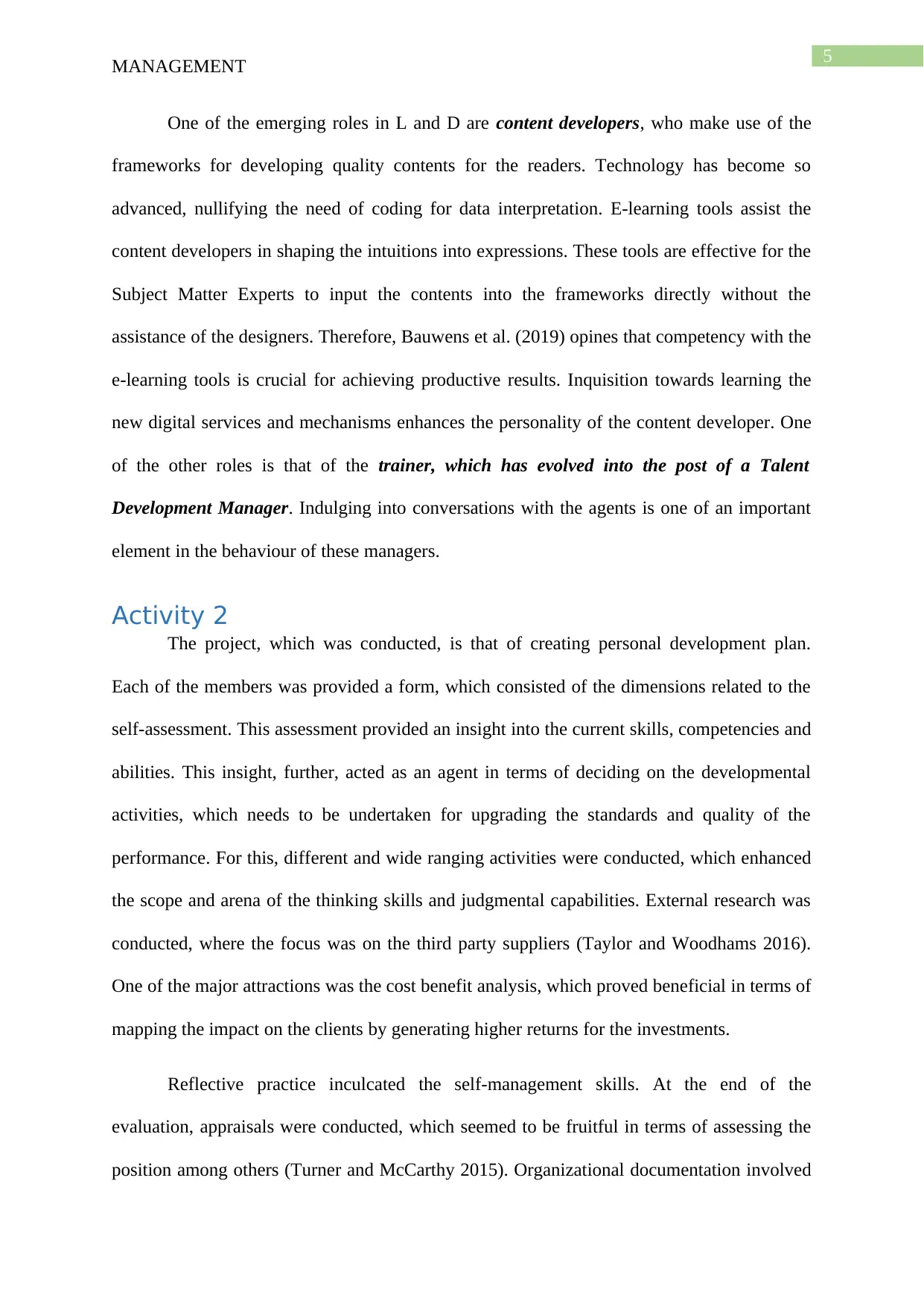
5
MANAGEMENT
One of the emerging roles in L and D are content developers, who make use of the
frameworks for developing quality contents for the readers. Technology has become so
advanced, nullifying the need of coding for data interpretation. E-learning tools assist the
content developers in shaping the intuitions into expressions. These tools are effective for the
Subject Matter Experts to input the contents into the frameworks directly without the
assistance of the designers. Therefore, Bauwens et al. (2019) opines that competency with the
e-learning tools is crucial for achieving productive results. Inquisition towards learning the
new digital services and mechanisms enhances the personality of the content developer. One
of the other roles is that of the trainer, which has evolved into the post of a Talent
Development Manager. Indulging into conversations with the agents is one of an important
element in the behaviour of these managers.
Activity 2
The project, which was conducted, is that of creating personal development plan.
Each of the members was provided a form, which consisted of the dimensions related to the
self-assessment. This assessment provided an insight into the current skills, competencies and
abilities. This insight, further, acted as an agent in terms of deciding on the developmental
activities, which needs to be undertaken for upgrading the standards and quality of the
performance. For this, different and wide ranging activities were conducted, which enhanced
the scope and arena of the thinking skills and judgmental capabilities. External research was
conducted, where the focus was on the third party suppliers (Taylor and Woodhams 2016).
One of the major attractions was the cost benefit analysis, which proved beneficial in terms of
mapping the impact on the clients by generating higher returns for the investments.
Reflective practice inculcated the self-management skills. At the end of the
evaluation, appraisals were conducted, which seemed to be fruitful in terms of assessing the
position among others (Turner and McCarthy 2015). Organizational documentation involved
MANAGEMENT
One of the emerging roles in L and D are content developers, who make use of the
frameworks for developing quality contents for the readers. Technology has become so
advanced, nullifying the need of coding for data interpretation. E-learning tools assist the
content developers in shaping the intuitions into expressions. These tools are effective for the
Subject Matter Experts to input the contents into the frameworks directly without the
assistance of the designers. Therefore, Bauwens et al. (2019) opines that competency with the
e-learning tools is crucial for achieving productive results. Inquisition towards learning the
new digital services and mechanisms enhances the personality of the content developer. One
of the other roles is that of the trainer, which has evolved into the post of a Talent
Development Manager. Indulging into conversations with the agents is one of an important
element in the behaviour of these managers.
Activity 2
The project, which was conducted, is that of creating personal development plan.
Each of the members was provided a form, which consisted of the dimensions related to the
self-assessment. This assessment provided an insight into the current skills, competencies and
abilities. This insight, further, acted as an agent in terms of deciding on the developmental
activities, which needs to be undertaken for upgrading the standards and quality of the
performance. For this, different and wide ranging activities were conducted, which enhanced
the scope and arena of the thinking skills and judgmental capabilities. External research was
conducted, where the focus was on the third party suppliers (Taylor and Woodhams 2016).
One of the major attractions was the cost benefit analysis, which proved beneficial in terms of
mapping the impact on the clients by generating higher returns for the investments.
Reflective practice inculcated the self-management skills. At the end of the
evaluation, appraisals were conducted, which seemed to be fruitful in terms of assessing the
position among others (Turner and McCarthy 2015). Organizational documentation involved
⊘ This is a preview!⊘
Do you want full access?
Subscribe today to unlock all pages.

Trusted by 1+ million students worldwide
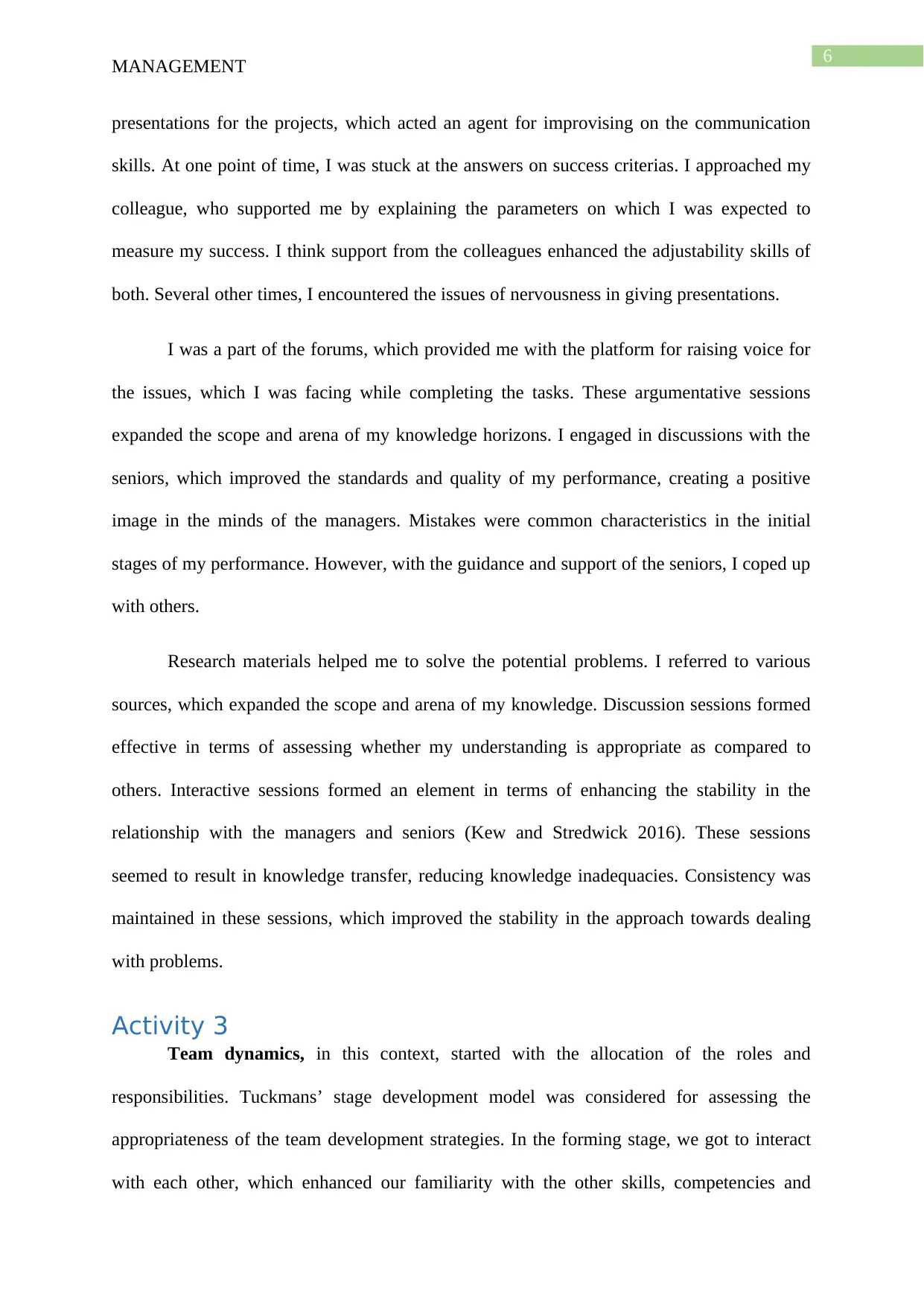
6
MANAGEMENT
presentations for the projects, which acted an agent for improvising on the communication
skills. At one point of time, I was stuck at the answers on success criterias. I approached my
colleague, who supported me by explaining the parameters on which I was expected to
measure my success. I think support from the colleagues enhanced the adjustability skills of
both. Several other times, I encountered the issues of nervousness in giving presentations.
I was a part of the forums, which provided me with the platform for raising voice for
the issues, which I was facing while completing the tasks. These argumentative sessions
expanded the scope and arena of my knowledge horizons. I engaged in discussions with the
seniors, which improved the standards and quality of my performance, creating a positive
image in the minds of the managers. Mistakes were common characteristics in the initial
stages of my performance. However, with the guidance and support of the seniors, I coped up
with others.
Research materials helped me to solve the potential problems. I referred to various
sources, which expanded the scope and arena of my knowledge. Discussion sessions formed
effective in terms of assessing whether my understanding is appropriate as compared to
others. Interactive sessions formed an element in terms of enhancing the stability in the
relationship with the managers and seniors (Kew and Stredwick 2016). These sessions
seemed to result in knowledge transfer, reducing knowledge inadequacies. Consistency was
maintained in these sessions, which improved the stability in the approach towards dealing
with problems.
Activity 3
Team dynamics, in this context, started with the allocation of the roles and
responsibilities. Tuckmans’ stage development model was considered for assessing the
appropriateness of the team development strategies. In the forming stage, we got to interact
with each other, which enhanced our familiarity with the other skills, competencies and
MANAGEMENT
presentations for the projects, which acted an agent for improvising on the communication
skills. At one point of time, I was stuck at the answers on success criterias. I approached my
colleague, who supported me by explaining the parameters on which I was expected to
measure my success. I think support from the colleagues enhanced the adjustability skills of
both. Several other times, I encountered the issues of nervousness in giving presentations.
I was a part of the forums, which provided me with the platform for raising voice for
the issues, which I was facing while completing the tasks. These argumentative sessions
expanded the scope and arena of my knowledge horizons. I engaged in discussions with the
seniors, which improved the standards and quality of my performance, creating a positive
image in the minds of the managers. Mistakes were common characteristics in the initial
stages of my performance. However, with the guidance and support of the seniors, I coped up
with others.
Research materials helped me to solve the potential problems. I referred to various
sources, which expanded the scope and arena of my knowledge. Discussion sessions formed
effective in terms of assessing whether my understanding is appropriate as compared to
others. Interactive sessions formed an element in terms of enhancing the stability in the
relationship with the managers and seniors (Kew and Stredwick 2016). These sessions
seemed to result in knowledge transfer, reducing knowledge inadequacies. Consistency was
maintained in these sessions, which improved the stability in the approach towards dealing
with problems.
Activity 3
Team dynamics, in this context, started with the allocation of the roles and
responsibilities. Tuckmans’ stage development model was considered for assessing the
appropriateness of the team development strategies. In the forming stage, we got to interact
with each other, which enhanced our familiarity with the other skills, competencies and
Paraphrase This Document
Need a fresh take? Get an instant paraphrase of this document with our AI Paraphraser
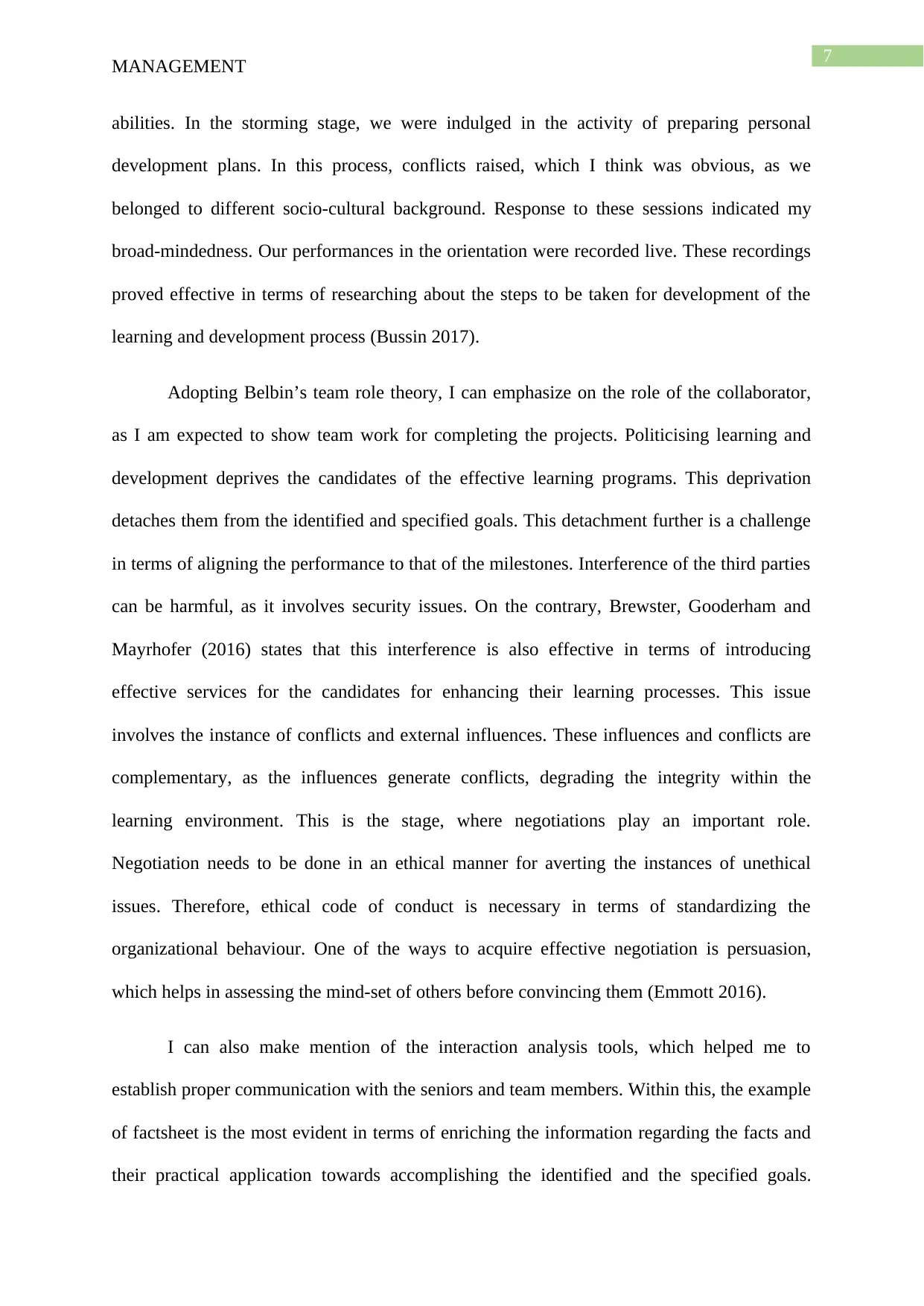
7
MANAGEMENT
abilities. In the storming stage, we were indulged in the activity of preparing personal
development plans. In this process, conflicts raised, which I think was obvious, as we
belonged to different socio-cultural background. Response to these sessions indicated my
broad-mindedness. Our performances in the orientation were recorded live. These recordings
proved effective in terms of researching about the steps to be taken for development of the
learning and development process (Bussin 2017).
Adopting Belbin’s team role theory, I can emphasize on the role of the collaborator,
as I am expected to show team work for completing the projects. Politicising learning and
development deprives the candidates of the effective learning programs. This deprivation
detaches them from the identified and specified goals. This detachment further is a challenge
in terms of aligning the performance to that of the milestones. Interference of the third parties
can be harmful, as it involves security issues. On the contrary, Brewster, Gooderham and
Mayrhofer (2016) states that this interference is also effective in terms of introducing
effective services for the candidates for enhancing their learning processes. This issue
involves the instance of conflicts and external influences. These influences and conflicts are
complementary, as the influences generate conflicts, degrading the integrity within the
learning environment. This is the stage, where negotiations play an important role.
Negotiation needs to be done in an ethical manner for averting the instances of unethical
issues. Therefore, ethical code of conduct is necessary in terms of standardizing the
organizational behaviour. One of the ways to acquire effective negotiation is persuasion,
which helps in assessing the mind-set of others before convincing them (Emmott 2016).
I can also make mention of the interaction analysis tools, which helped me to
establish proper communication with the seniors and team members. Within this, the example
of factsheet is the most evident in terms of enriching the information regarding the facts and
their practical application towards accomplishing the identified and the specified goals.
MANAGEMENT
abilities. In the storming stage, we were indulged in the activity of preparing personal
development plans. In this process, conflicts raised, which I think was obvious, as we
belonged to different socio-cultural background. Response to these sessions indicated my
broad-mindedness. Our performances in the orientation were recorded live. These recordings
proved effective in terms of researching about the steps to be taken for development of the
learning and development process (Bussin 2017).
Adopting Belbin’s team role theory, I can emphasize on the role of the collaborator,
as I am expected to show team work for completing the projects. Politicising learning and
development deprives the candidates of the effective learning programs. This deprivation
detaches them from the identified and specified goals. This detachment further is a challenge
in terms of aligning the performance to that of the milestones. Interference of the third parties
can be harmful, as it involves security issues. On the contrary, Brewster, Gooderham and
Mayrhofer (2016) states that this interference is also effective in terms of introducing
effective services for the candidates for enhancing their learning processes. This issue
involves the instance of conflicts and external influences. These influences and conflicts are
complementary, as the influences generate conflicts, degrading the integrity within the
learning environment. This is the stage, where negotiations play an important role.
Negotiation needs to be done in an ethical manner for averting the instances of unethical
issues. Therefore, ethical code of conduct is necessary in terms of standardizing the
organizational behaviour. One of the ways to acquire effective negotiation is persuasion,
which helps in assessing the mind-set of others before convincing them (Emmott 2016).
I can also make mention of the interaction analysis tools, which helped me to
establish proper communication with the seniors and team members. Within this, the example
of factsheet is the most evident in terms of enriching the information regarding the facts and
their practical application towards accomplishing the identified and the specified goals.
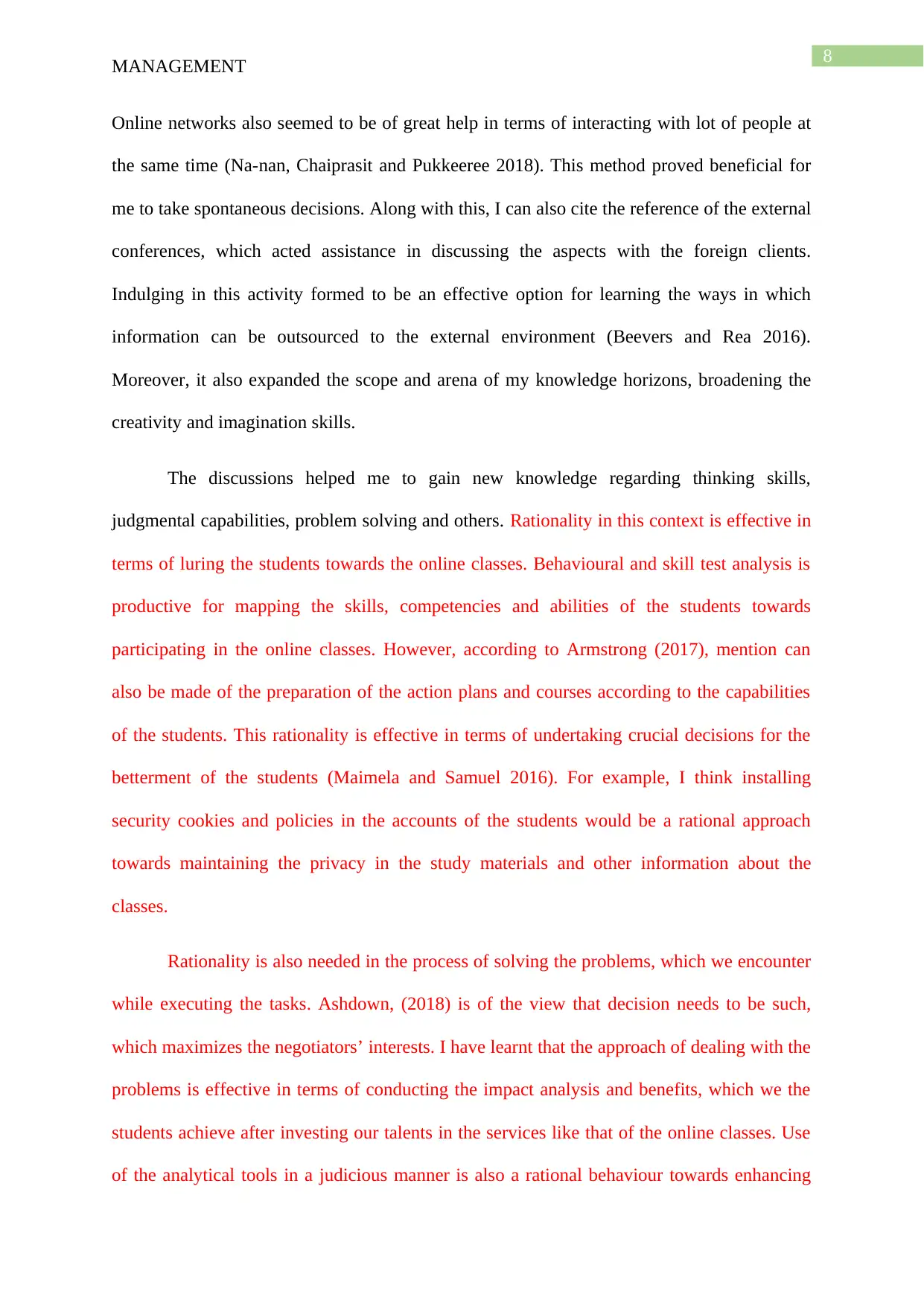
8
MANAGEMENT
Online networks also seemed to be of great help in terms of interacting with lot of people at
the same time (Na-nan, Chaiprasit and Pukkeeree 2018). This method proved beneficial for
me to take spontaneous decisions. Along with this, I can also cite the reference of the external
conferences, which acted assistance in discussing the aspects with the foreign clients.
Indulging in this activity formed to be an effective option for learning the ways in which
information can be outsourced to the external environment (Beevers and Rea 2016).
Moreover, it also expanded the scope and arena of my knowledge horizons, broadening the
creativity and imagination skills.
The discussions helped me to gain new knowledge regarding thinking skills,
judgmental capabilities, problem solving and others. Rationality in this context is effective in
terms of luring the students towards the online classes. Behavioural and skill test analysis is
productive for mapping the skills, competencies and abilities of the students towards
participating in the online classes. However, according to Armstrong (2017), mention can
also be made of the preparation of the action plans and courses according to the capabilities
of the students. This rationality is effective in terms of undertaking crucial decisions for the
betterment of the students (Maimela and Samuel 2016). For example, I think installing
security cookies and policies in the accounts of the students would be a rational approach
towards maintaining the privacy in the study materials and other information about the
classes.
Rationality is also needed in the process of solving the problems, which we encounter
while executing the tasks. Ashdown, (2018) is of the view that decision needs to be such,
which maximizes the negotiators’ interests. I have learnt that the approach of dealing with the
problems is effective in terms of conducting the impact analysis and benefits, which we the
students achieve after investing our talents in the services like that of the online classes. Use
of the analytical tools in a judicious manner is also a rational behaviour towards enhancing
MANAGEMENT
Online networks also seemed to be of great help in terms of interacting with lot of people at
the same time (Na-nan, Chaiprasit and Pukkeeree 2018). This method proved beneficial for
me to take spontaneous decisions. Along with this, I can also cite the reference of the external
conferences, which acted assistance in discussing the aspects with the foreign clients.
Indulging in this activity formed to be an effective option for learning the ways in which
information can be outsourced to the external environment (Beevers and Rea 2016).
Moreover, it also expanded the scope and arena of my knowledge horizons, broadening the
creativity and imagination skills.
The discussions helped me to gain new knowledge regarding thinking skills,
judgmental capabilities, problem solving and others. Rationality in this context is effective in
terms of luring the students towards the online classes. Behavioural and skill test analysis is
productive for mapping the skills, competencies and abilities of the students towards
participating in the online classes. However, according to Armstrong (2017), mention can
also be made of the preparation of the action plans and courses according to the capabilities
of the students. This rationality is effective in terms of undertaking crucial decisions for the
betterment of the students (Maimela and Samuel 2016). For example, I think installing
security cookies and policies in the accounts of the students would be a rational approach
towards maintaining the privacy in the study materials and other information about the
classes.
Rationality is also needed in the process of solving the problems, which we encounter
while executing the tasks. Ashdown, (2018) is of the view that decision needs to be such,
which maximizes the negotiators’ interests. I have learnt that the approach of dealing with the
problems is effective in terms of conducting the impact analysis and benefits, which we the
students achieve after investing our talents in the services like that of the online classes. Use
of the analytical tools in a judicious manner is also a rational behaviour towards enhancing
⊘ This is a preview!⊘
Do you want full access?
Subscribe today to unlock all pages.

Trusted by 1+ million students worldwide
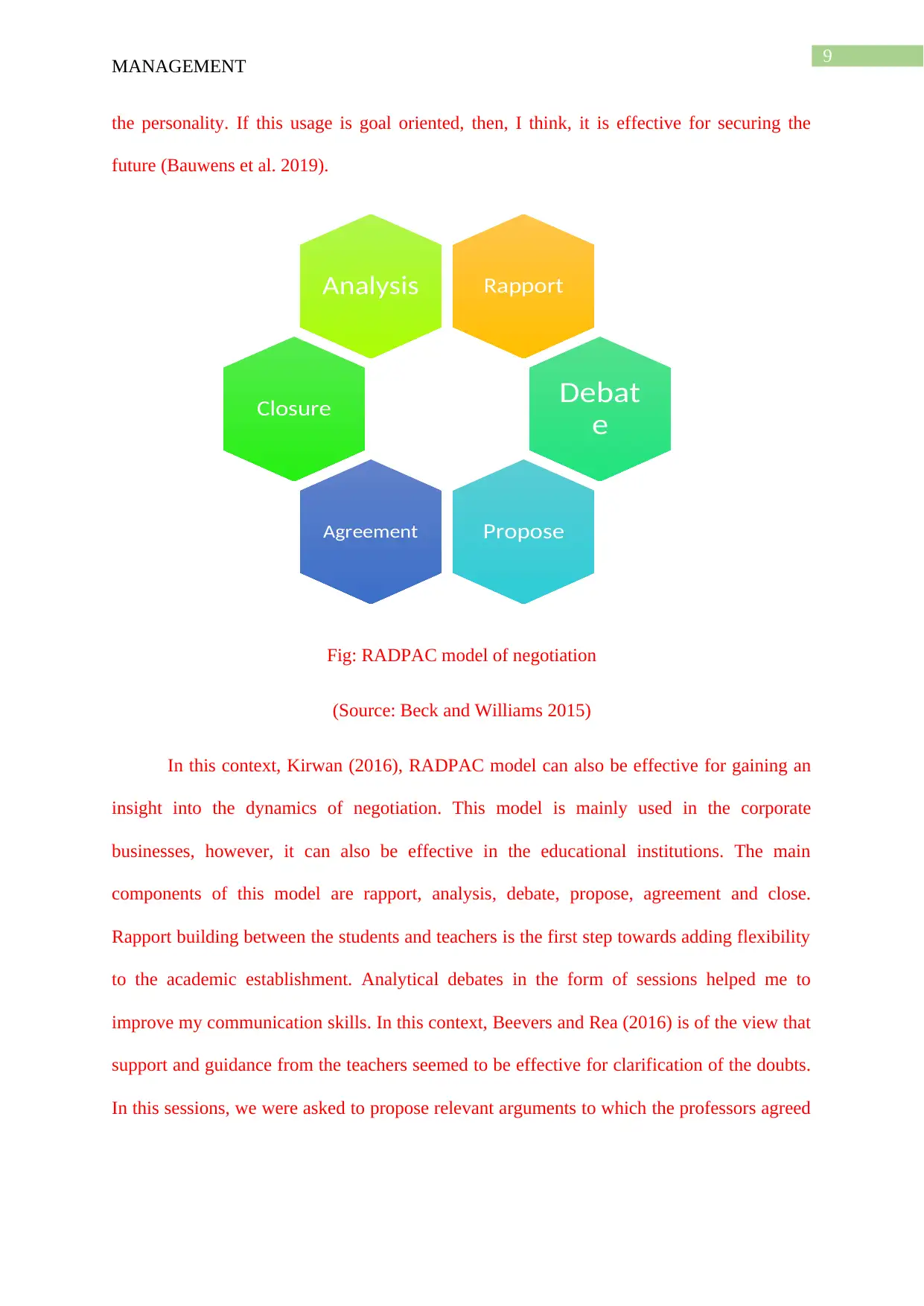
9
MANAGEMENT
the personality. If this usage is goal oriented, then, I think, it is effective for securing the
future (Bauwens et al. 2019).
Fig: RADPAC model of negotiation
(Source: Beck and Williams 2015)
In this context, Kirwan (2016), RADPAC model can also be effective for gaining an
insight into the dynamics of negotiation. This model is mainly used in the corporate
businesses, however, it can also be effective in the educational institutions. The main
components of this model are rapport, analysis, debate, propose, agreement and close.
Rapport building between the students and teachers is the first step towards adding flexibility
to the academic establishment. Analytical debates in the form of sessions helped me to
improve my communication skills. In this context, Beevers and Rea (2016) is of the view that
support and guidance from the teachers seemed to be effective for clarification of the doubts.
In this sessions, we were asked to propose relevant arguments to which the professors agreed
RapportAnalysis
Closure Debat
e
ProposeAgreement
MANAGEMENT
the personality. If this usage is goal oriented, then, I think, it is effective for securing the
future (Bauwens et al. 2019).
Fig: RADPAC model of negotiation
(Source: Beck and Williams 2015)
In this context, Kirwan (2016), RADPAC model can also be effective for gaining an
insight into the dynamics of negotiation. This model is mainly used in the corporate
businesses, however, it can also be effective in the educational institutions. The main
components of this model are rapport, analysis, debate, propose, agreement and close.
Rapport building between the students and teachers is the first step towards adding flexibility
to the academic establishment. Analytical debates in the form of sessions helped me to
improve my communication skills. In this context, Beevers and Rea (2016) is of the view that
support and guidance from the teachers seemed to be effective for clarification of the doubts.
In this sessions, we were asked to propose relevant arguments to which the professors agreed
RapportAnalysis
Closure Debat
e
ProposeAgreement
Paraphrase This Document
Need a fresh take? Get an instant paraphrase of this document with our AI Paraphraser
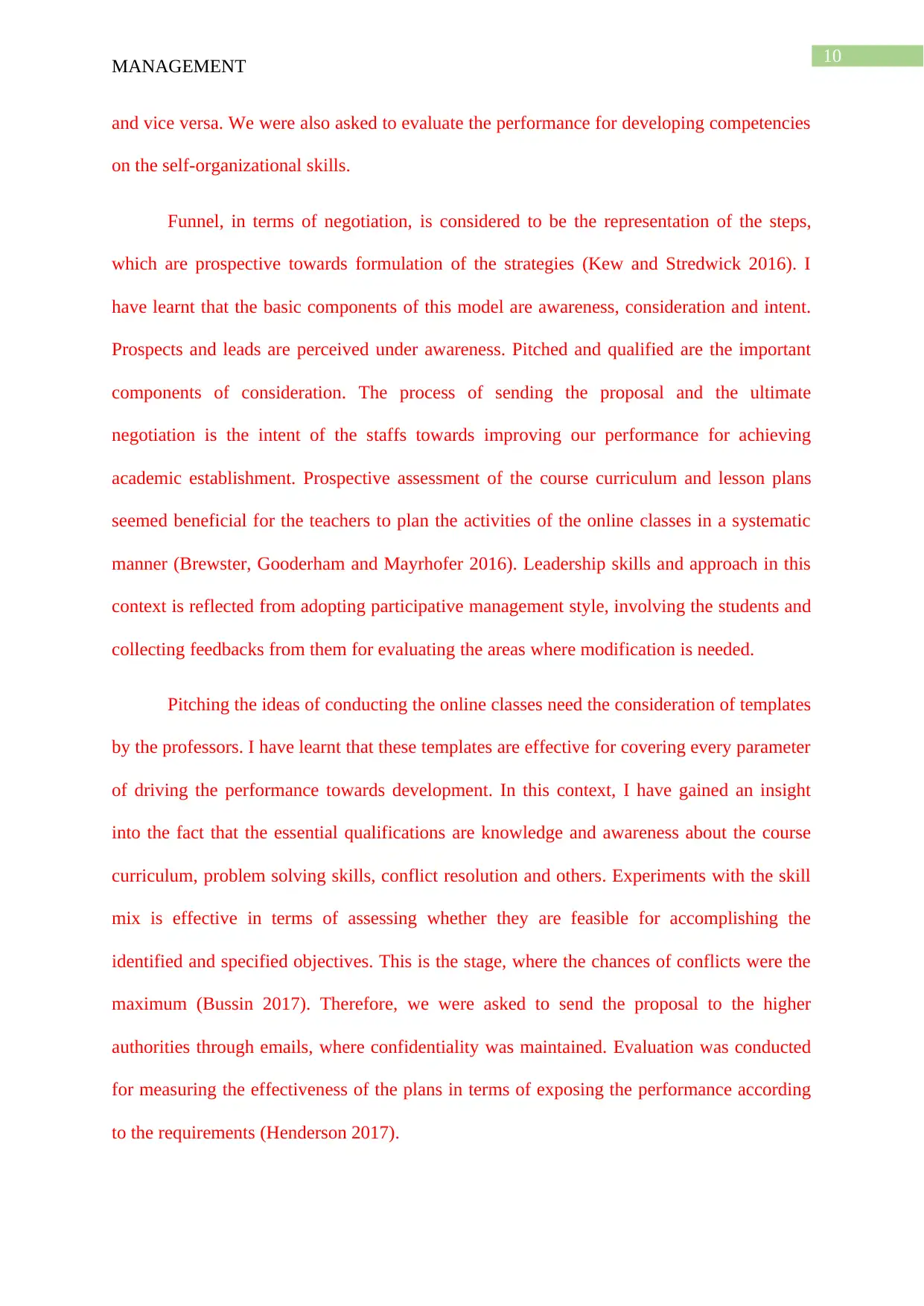
10
MANAGEMENT
and vice versa. We were also asked to evaluate the performance for developing competencies
on the self-organizational skills.
Funnel, in terms of negotiation, is considered to be the representation of the steps,
which are prospective towards formulation of the strategies (Kew and Stredwick 2016). I
have learnt that the basic components of this model are awareness, consideration and intent.
Prospects and leads are perceived under awareness. Pitched and qualified are the important
components of consideration. The process of sending the proposal and the ultimate
negotiation is the intent of the staffs towards improving our performance for achieving
academic establishment. Prospective assessment of the course curriculum and lesson plans
seemed beneficial for the teachers to plan the activities of the online classes in a systematic
manner (Brewster, Gooderham and Mayrhofer 2016). Leadership skills and approach in this
context is reflected from adopting participative management style, involving the students and
collecting feedbacks from them for evaluating the areas where modification is needed.
Pitching the ideas of conducting the online classes need the consideration of templates
by the professors. I have learnt that these templates are effective for covering every parameter
of driving the performance towards development. In this context, I have gained an insight
into the fact that the essential qualifications are knowledge and awareness about the course
curriculum, problem solving skills, conflict resolution and others. Experiments with the skill
mix is effective in terms of assessing whether they are feasible for accomplishing the
identified and specified objectives. This is the stage, where the chances of conflicts were the
maximum (Bussin 2017). Therefore, we were asked to send the proposal to the higher
authorities through emails, where confidentiality was maintained. Evaluation was conducted
for measuring the effectiveness of the plans in terms of exposing the performance according
to the requirements (Henderson 2017).
MANAGEMENT
and vice versa. We were also asked to evaluate the performance for developing competencies
on the self-organizational skills.
Funnel, in terms of negotiation, is considered to be the representation of the steps,
which are prospective towards formulation of the strategies (Kew and Stredwick 2016). I
have learnt that the basic components of this model are awareness, consideration and intent.
Prospects and leads are perceived under awareness. Pitched and qualified are the important
components of consideration. The process of sending the proposal and the ultimate
negotiation is the intent of the staffs towards improving our performance for achieving
academic establishment. Prospective assessment of the course curriculum and lesson plans
seemed beneficial for the teachers to plan the activities of the online classes in a systematic
manner (Brewster, Gooderham and Mayrhofer 2016). Leadership skills and approach in this
context is reflected from adopting participative management style, involving the students and
collecting feedbacks from them for evaluating the areas where modification is needed.
Pitching the ideas of conducting the online classes need the consideration of templates
by the professors. I have learnt that these templates are effective for covering every parameter
of driving the performance towards development. In this context, I have gained an insight
into the fact that the essential qualifications are knowledge and awareness about the course
curriculum, problem solving skills, conflict resolution and others. Experiments with the skill
mix is effective in terms of assessing whether they are feasible for accomplishing the
identified and specified objectives. This is the stage, where the chances of conflicts were the
maximum (Bussin 2017). Therefore, we were asked to send the proposal to the higher
authorities through emails, where confidentiality was maintained. Evaluation was conducted
for measuring the effectiveness of the plans in terms of exposing the performance according
to the requirements (Henderson 2017).
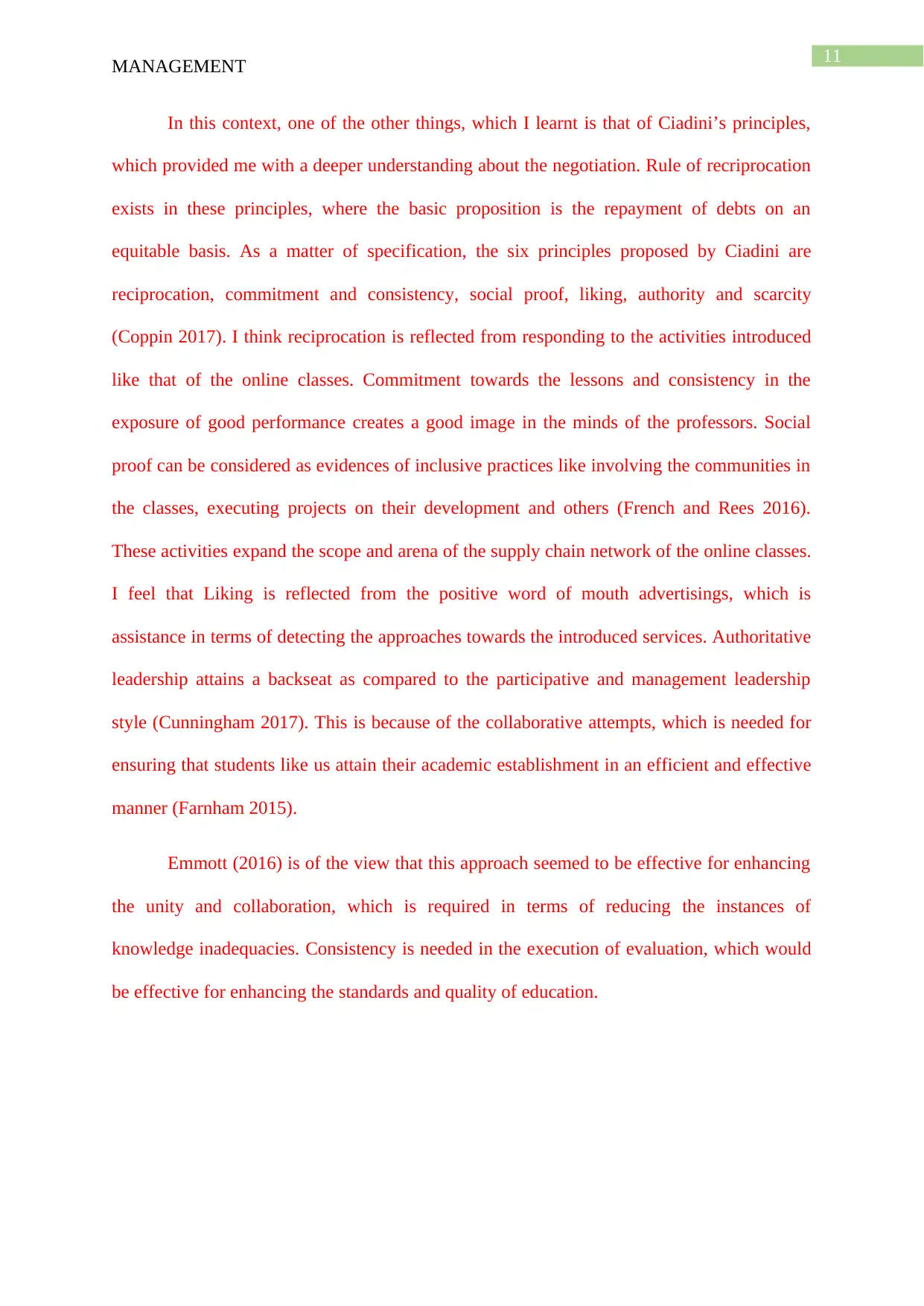
11
MANAGEMENT
In this context, one of the other things, which I learnt is that of Ciadini’s principles,
which provided me with a deeper understanding about the negotiation. Rule of recriprocation
exists in these principles, where the basic proposition is the repayment of debts on an
equitable basis. As a matter of specification, the six principles proposed by Ciadini are
reciprocation, commitment and consistency, social proof, liking, authority and scarcity
(Coppin 2017). I think reciprocation is reflected from responding to the activities introduced
like that of the online classes. Commitment towards the lessons and consistency in the
exposure of good performance creates a good image in the minds of the professors. Social
proof can be considered as evidences of inclusive practices like involving the communities in
the classes, executing projects on their development and others (French and Rees 2016).
These activities expand the scope and arena of the supply chain network of the online classes.
I feel that Liking is reflected from the positive word of mouth advertisings, which is
assistance in terms of detecting the approaches towards the introduced services. Authoritative
leadership attains a backseat as compared to the participative and management leadership
style (Cunningham 2017). This is because of the collaborative attempts, which is needed for
ensuring that students like us attain their academic establishment in an efficient and effective
manner (Farnham 2015).
Emmott (2016) is of the view that this approach seemed to be effective for enhancing
the unity and collaboration, which is required in terms of reducing the instances of
knowledge inadequacies. Consistency is needed in the execution of evaluation, which would
be effective for enhancing the standards and quality of education.
MANAGEMENT
In this context, one of the other things, which I learnt is that of Ciadini’s principles,
which provided me with a deeper understanding about the negotiation. Rule of recriprocation
exists in these principles, where the basic proposition is the repayment of debts on an
equitable basis. As a matter of specification, the six principles proposed by Ciadini are
reciprocation, commitment and consistency, social proof, liking, authority and scarcity
(Coppin 2017). I think reciprocation is reflected from responding to the activities introduced
like that of the online classes. Commitment towards the lessons and consistency in the
exposure of good performance creates a good image in the minds of the professors. Social
proof can be considered as evidences of inclusive practices like involving the communities in
the classes, executing projects on their development and others (French and Rees 2016).
These activities expand the scope and arena of the supply chain network of the online classes.
I feel that Liking is reflected from the positive word of mouth advertisings, which is
assistance in terms of detecting the approaches towards the introduced services. Authoritative
leadership attains a backseat as compared to the participative and management leadership
style (Cunningham 2017). This is because of the collaborative attempts, which is needed for
ensuring that students like us attain their academic establishment in an efficient and effective
manner (Farnham 2015).
Emmott (2016) is of the view that this approach seemed to be effective for enhancing
the unity and collaboration, which is required in terms of reducing the instances of
knowledge inadequacies. Consistency is needed in the execution of evaluation, which would
be effective for enhancing the standards and quality of education.
⊘ This is a preview!⊘
Do you want full access?
Subscribe today to unlock all pages.

Trusted by 1+ million students worldwide
1 out of 17
Related Documents
Your All-in-One AI-Powered Toolkit for Academic Success.
+13062052269
info@desklib.com
Available 24*7 on WhatsApp / Email
![[object Object]](/_next/static/media/star-bottom.7253800d.svg)
Unlock your academic potential
Copyright © 2020–2025 A2Z Services. All Rights Reserved. Developed and managed by ZUCOL.





